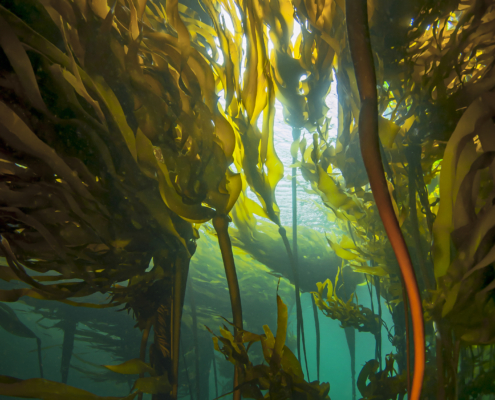The Origins of PSF’s Marine Science Program
The salmon lifecycle takes them from riverbeds to estuaries and then through thousands of miles of ocean habitat before returning to their natal rivers to reproduce and start the lifecycle all over again. The Marine Science Program’s research focuses on furthering understanding of Pacific salmon survival in our estuaries and oceans – which plays a critical role in determining the number of salmon that are caught in fisheries or return to their home rivers to reproduce.
Primarily due to increased hatchery production of pink and chum salmon from the United States, Russia, Japan, and Canada, the abundance of salmon in the North Pacific has reached record highs in recent years. However, all west coast North American Chinook salmon populations are struggling, and southern populations of coho, sockeye and steelhead are similarly compromised.
These patterns of decline were generally assumed to be caused by human impacts to freshwater environments and were particularly pronounced in more developed southern regions with higher population densities. Consequently, salmon recovery efforts that began in the late 1990s focused almost exclusively on understanding and addressing harvest, freshwater and estuary habitats, and hatchery impact. Little emphasis was put on the marine ecosystem. Millions of dollars were invested in freshwater habitat restoration and implementation of hatcheries, but Pacific salmon have continued to decline. Not until recently has greater attention been placed on studying salmon’s marine life cycle and the impacts it might have on their survival.
Since the 1990s smolt to adult survival for Chinook have dropped to about one-third of early levels nearly everywhere along the west coast of North America including in the Salish Sea, the west coast of Vancouver Island, and the Columbia Basin, suggesting that salmon may be experiencing common challenges across broad oceanic regions.
Such findings led to the Salish Sea Marine Survival Project (SSMSP) – a major five-year transboundary project that investigated why salmon populations abruptly crashed in the Salish Sea in the 1990s and never recovered. SSMSP underscored our commitment to studying salmon in nearshore and marine environments; detecting causes of reduced marine survival, and implementing actions to eliminate or reduce stressors in the marine environment.
The Marine Science Program: Five Pillar Approach
The PSF Marine Science Program Plan was developed based on the key findings and recommendations of the SSMSP. A set of five “pillars” guides the application of targeted science and the development of guidance and applied actions for salmon recovery which includes a clear focus on climate change.
Understand Bottlenecks to Salmon Survival
Identify factors limiting salmon survival, address critical knowledge gaps and potential future risks under a changing climate in estuarine and marine environments.
 The first pillar focuses on continuing to build our understanding of the key bottlenecks to salmon survival, assessing where, when, and why particular stressors are impacting salmon growth and survival. In particular, we are interested in how climate change will impact the entire salmon food web – from plankton to forage fish and ultimately, salmon. We also wish to consider other threats, both anthropogenic (such as contaminants and microplastics) and biological (such as predators and invasive species).
The first pillar focuses on continuing to build our understanding of the key bottlenecks to salmon survival, assessing where, when, and why particular stressors are impacting salmon growth and survival. In particular, we are interested in how climate change will impact the entire salmon food web – from plankton to forage fish and ultimately, salmon. We also wish to consider other threats, both anthropogenic (such as contaminants and microplastics) and biological (such as predators and invasive species).


 Using the information from Pillar 1, we can develop action plans to address factors limiting habitat restoration. Crucial components of these action plans will be a) prioritizing and orchestrating our actions in time and space, b) developing optimal strategies for action and c) adaptively learning from what has been done before. This pillar focuses on development of tools such as the Risk Assessment Methodology for Salmon (RAMS) which can prioritize the highest risk limiting factors. It will also develop decision support tools for guiding restoration actions and other guidance products such as practical restoration manuals, maps, and workshop summaries.
Using the information from Pillar 1, we can develop action plans to address factors limiting habitat restoration. Crucial components of these action plans will be a) prioritizing and orchestrating our actions in time and space, b) developing optimal strategies for action and c) adaptively learning from what has been done before. This pillar focuses on development of tools such as the Risk Assessment Methodology for Salmon (RAMS) which can prioritize the highest risk limiting factors. It will also develop decision support tools for guiding restoration actions and other guidance products such as practical restoration manuals, maps, and workshop summaries.
 The next pillar is to translate and share our work – meaning that we take the knowledge that we are building through the Marine Science Program, and produce accessible products that allow the public, scientists, stewardship groups, and restoration practitioners to understand salmon research outcomes and restoration methodologies and actions underway. Through this work we hope to encourage positive and successful action, build informed communities, and ultimately encourage more investment and interest in salmon and their conservation.
The next pillar is to translate and share our work – meaning that we take the knowledge that we are building through the Marine Science Program, and produce accessible products that allow the public, scientists, stewardship groups, and restoration practitioners to understand salmon research outcomes and restoration methodologies and actions underway. Through this work we hope to encourage positive and successful action, build informed communities, and ultimately encourage more investment and interest in salmon and their conservation.